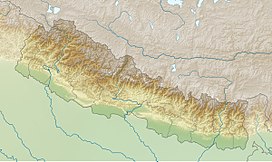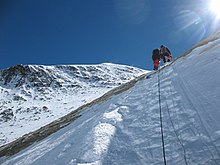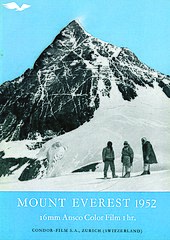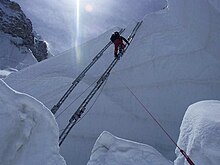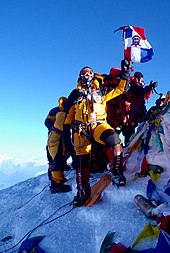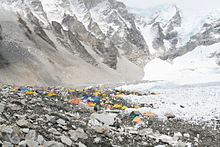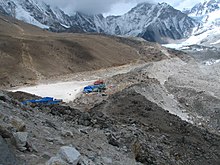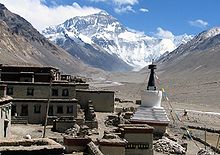From Wikipedia, the free encyclopedia
| Mount Everest | |
|---|---|
| सगरमाथा (Sagarmāthā) ཇོ་མོ་གླང་མ (Chomolungma) 珠穆朗玛峰 (Zhūmùlǎngmǎ Fēng) |
|
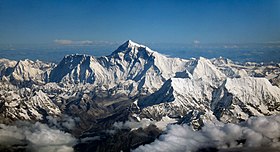
Aerial photo from the south, behind Nuptse and Lhotse
|
|
| Elevation | 8,848 m (29,029 ft)[1] Ranked 1st |
| Prominence | 8,848 m (29,029 ft) Ranked 1st (Notice special definition for Everest) |
| Listing | Seven Summits Eight-thousander Country high point Ultra |
| Location | |
| Location on the Sagarmatha Zone, Nepal - Tibet, China border | |
| Location | Solukhumbu District, Sagarmatha Zone, Nepal; Tingri County, Xigazê, Tibet Autonomous Region, China[2] |
| Range | Mahalangur Himal, Himalayas |
| Coordinates | 27°59′17″N 86°55′31″E / 27.98806°N 86.92528°ECoordinates: 27°59′17″N 86°55′31″E / 27.98806°N 86.92528°E[3] |
| Climbing | |
| First ascent | 29 May 1953 Edmund Hillary and Tenzing Norgay (First winter ascent 1980 Leszek Cichy and Krzysztof Wielicki[4][5]) |
| Easiest route | South Col (Nepal) |
Mount Everest, also known in Nepal as Sagarmāthā and in Tibet as Chomolungma, is Earth's highest mountain. It is located in the Mahalangur section of the Himalayas. Its peak is 8,848 metres (29,029 ft) above sea level[1] and is the 5th furthest summit from the center of Earth.[6] The international border between China and Nepal runs across the precise summit point. Its massif includes neighboring peaks Lhotse, 8,516 m (27,940 ft); Nuptse, 7,855 m (25,771 ft) and Changtse, 7,580 m (24,870 ft).
In 1856, the Great Trigonometrical Survey of India established the first published height of Everest, then known as Peak XV, at 29,002 ft (8,840 m). The current official height of 8,848 m (29,029 ft) as recognized by Nepal and China was established by a 1955 Indian survey and subsequently confirmed by a Chinese survey in 1975. In 1865, Everest was given its official English name by the Royal Geographical Society upon a recommendation by Andrew Waugh, the British Surveyor General of India. Waugh named the mountain after his predecessor in the post, Sir George Everest, arguing that there were many local names, against the opinion of Everest.[7]
Mount Everest attracts many highly experienced mountaineers as well as capable climbers willing to hire professional guides. There are two main climbing routes, one approaching the summit from the southeast in Nepal (known as the standard route) and the other from the north in Tibet. While not posing substantial technical climbing challenges on the standard route, Everest presents dangers such as altitude sickness, weather, wind as well as significant objective hazards from avalanches and the Khumbu Icefall. While the overwhelming majority of climbers use bottled oxygen in order to reach the top, some climbers have summitted Everest without supplemental oxygen.
The first recorded efforts to reach Everest's summit were made by British mountaineers. With Nepal not allowing foreigners into the country at the time, the British made several attempts on the north ridge route from the Tibetan side. After the first reconnaissance expedition by the British in 1921 reached 7,000 m (22,970 ft) on the North Col, the 1922 expedition pushed the North ridge route up to 8,320 m (27,300 ft) marking the first time a human had climbed above 8,000 m (26,247 ft). Tragedy struck on the descent from the North col when seven porters were killed in an avalanche. The 1924 expedition resulted in the greatest mystery on Everest to this day: George Mallory and Andrew Irvine made a final summit attempt on June 8 but never returned, sparking debate as to whether they were the first to reach the top. They had been spotted high on the mountain that day but disappeared in the clouds, never to be seen again until Mallory's body was found in 1999 at 8,155 m (26,755 ft) on the North face. Tenzing Norgay and Edmund Hillary made the first official ascent of Everest in 1953 using the southeast ridge route. Tenzing had reached 8,595 m (28,199 ft) the previous year as a member of the 1952 Swiss expedition.
Discovery
In 1802, the British began the Great Trigonometric Survey of India to determine the location and names of the world's highest mountains. Starting in southern India, the survey teams moved northward using giant theodolites, each weighing 500 kg (1,100 lb) and requiring 12 men to carry, to measure heights as accurately as possible. They reached the Himalayan foothills by the 1830s, but Nepal was unwilling to allow the British to enter the country because of suspicions of political aggression and possible annexation. Several requests by the surveyors to enter Nepal were turned down.[8]
The British were forced to continue their observations from Terai, a region south of Nepal which is parallel to the Himalayas. Conditions in Terai were difficult because of torrential rains and malaria. Three survey officers died from malaria while two others had to retire due to failing health.[8]
Nonetheless, in 1847, the British continued the Great Trigonometric survey and began detailed observations of the Himalayan peaks from observation stations up to 240 km (150 mi) away. Weather restricted work to the last three months of the year. In November 1847, Andrew Waugh, the British Surveyor General of India made several observations from the Sawajpore station located in the eastern end of the Himalayas. Kangchenjunga was then considered the highest peak in the world, and with interest he noted a peak beyond it, about 230 km (140 mi) away. John Armstrong, one of Waugh's officials, also saw the peak from a location farther west and called it peak "b". Waugh would later write that the observations indicated that peak "b" was higher than Kangchenjunga, but given the great distance of the observations, closer observations were required for verification. The following year, Waugh sent a survey official back to Terai to make closer observations of peak "b", but clouds thwarted all attempts.[8]
In 1849, Waugh dispatched James Nicolson to the area, who made two observations from Jirol, 190 km (120 mi) away. Nicolson then took the largest theodolite and headed east, obtaining over 30 observations from five different locations, with the closest being 174 km (108 mi) from the peak.[8]
Nicolson retreated to Patna on the Ganges to perform the necessary calculations based on his observations. His raw data gave an average height of 9,200 m (30,200 ft) for peak "b", but this did not consider light refraction, which distorts heights. However, the number clearly indicated, that peak "b" was higher than Kangchenjunga. Then, Nicolson contracted malaria and was forced to return home without finishing his calculations. Michael Hennessy, one of Waugh's assistants, had begun designating peaks based on Roman numerals, with Kangchenjunga named Peak IX, while peak "b" now became known as Peak XV.[8]
In 1852, stationed at the survey headquarters in Dehradun, Radhanath Sikdar, an Indian mathematician and surveyor from Bengal, was the first to identify Everest as the world's highest peak, using trigonometric calculations based on Nicolson's measurements.[9] An official announcement that Peak XV was the highest was delayed for several years as the calculations were repeatedly verified. Waugh began work on Nicolson's data in 1854, and along with his staff spent almost two years working on the calculations, having to deal with the problems of light refraction, barometric pressure, and temperature over the vast distances of the observations. Finally, in March 1856 he announced his findings in a letter to his deputy in Calcutta. Kangchenjunga was declared to be 28,156 ft (8,582 m), while Peak XV was given the height of 29,002 ft (8,840 m). Waugh concluded that Peak XV was "most probably the highest in the world".[8] Peak XV (measured in feet) was calculated to be exactly 29,000 ft (8,839.2 m) high, but was publicly declared to be 29,002 ft (8,839.8 m) in order to avoid the impression that an exact height of 29,000 feet (8,839.2 m) was nothing more than a rounded estimate.[10] Waugh is therefore wittily credited with being "the first person to put two feet on top of Mount Everest".
Name
| Mount Everest | |||

The north face of Mount Everest
|
|||
| Chomolungma[12][13] | |||
|---|---|---|---|
| Traditional Chinese | 珠穆朗瑪峰 | ||
| Simplified Chinese | 珠穆朗玛峰[11] | ||
| Literal meaning | Chomolungma Peak | ||
|
|||
| Tibetan name | |||
| Tibetan | ཇོ་མོ་གླང་མ | ||
|
|||
| Nepali name | |||
| Nepali | सगरमाथा[14] | ||
| Nepali Romanisation name | |||
| Nepali Romanisation | Sagarmāthā | ||
| British Survey name | |||
| British Survey | Peak XV | ||
While the survey wanted to preserve local names if possible (e.g. Kangchenjunga and Dhaulagiri), Waugh argued that he could not find any commonly used local name. Waugh's search for a local name was hampered by Nepal and Tibet's exclusion of foreigners. Many local names existed, including "Deodungha" ("Holy Mountain") in Darjeeling[15] and the Tibetan "Chomolungma", which appeared on a 1733 map published in Paris by the French geographer D'Anville. In the late 19th century, many European cartographers further believed (incorrectly) that a native name for the mountain was "Gaurisankar".[16] (Gauri Sankar is a mountain between Kathmandu and Everest.)
Waugh argued that because there were many local names, it would be difficult to favour one name over all others, so he decided that Peak XV should be named after Welsh surveyor George Everest, his predecessor as Surveyor General of India.[8][17][18]
George Everest opposed the name suggested by Waugh and told the Royal Geographical Society in 1857 that Everest could not be written in Hindi nor pronounced by "the native of India". Waugh's proposed name prevailed despite the objections, and in 1865, the Royal Geographical Society officially adopted Mount Everest as the name for the highest mountain in the world.[8] The modern pronunciation of Everest /ˈɛvərɨst, ˈɛvrɨst/[19] is different from Sir George's pronunciation of his surname, which was /ˈiːvrɨst/ (EEV-rist).[20]
The Tibetan name for Mount Everest is ཇོ་མོ་གླང་མ (IPA: [t͡ɕʰòmòlɑ́ŋmɑ̀],[citation needed] lit. "Holy Mother"), whose official pinyin romanization is Qomolangma. It is also popularly romanised as Chomolungma and (in Wylie) as Jo-mo-glang-ma or Jomo Langma.[25] The official Chinese transcription is simplified Chinese: 珠穆朗玛峰; traditional Chinese: 珠穆朗瑪峰 whose pinyin form is Zhūmùlǎngmǎ Fēng ("Chomolungma Peak").[26] It is also infrequently simply translated into Chinese as Shèngmǔ Fēng (圣母峰; 聖母峰; "Holy Mother Peak"). In 2002, the Chinese People's Daily newspaper published an article making a case against the use of "Mount Everest" for the mountain in English, insisting that it should be referred to as "Mount Qomolangma",[26] based on the local Tibetan name. The article argued that British colonialists did not "first discover" the mountain, as it had been known to the Tibetans and mapped by the Chinese as "Qomolangma" since at least 1719.[27]
In the early 1960s, the Nepalese government coined a Nepali name for Mount Everest, Sagarmāthā or Sagar-Matha[28] (सगरमाथा[29]), allegedly to supplant the Tibetan name among the locals, which the Nepali government felt was "not acceptable".[citation needed]
Surveys

Published by the Survey of Nepal, this is Map 50 of the 57 map set at 1:50,000 scale "attached to the main text on the First Joint Inspection Survey, 1979–80, Nepal-China border." In the top center, note the boundary line, identified as separating "China" and "Nepal", passing exactly through the summit contour. The boundary here and for much of the China-Nepal border follows the main Himalayan watershed divide.
The 8,848 m (29,029 ft) height given is officially recognised by Nepal and China,[30] although Nepal is planning a new survey.[31]
In 1856, Andrew Waugh announced Everest (then known as Peak XV) as 29,002 ft (8,840 m) high, after several years of calculations based on observations made by the Great Trigonometric Survey.
The elevation of 8,848 m (29,029 ft) was first determined by an Indian survey in 1955, made closer to the mountain, also using theodolites.[citation needed] It was subsequently reaffirmed by a 1975 Chinese measurement 8,848.13 m (29,029.30 ft).[32] In both cases the snow cap, not the rock head, was measured. In May 1999 an American Everest Expedition, directed by Bradford Washburn, anchored a GPS unit into the highest bedrock. A rock head elevation of 8,850 m (29,035 ft), and a snow/ice elevation 1 m (3 ft) higher, were obtained via this device.[33] Although it has not been officially recognized by Nepal,[34] this figure is widely quoted. Geoid uncertainty casts doubt upon the accuracy claimed by both the 1999 and 2005 surveys.
A detailed photogrammetric map (at a scale of 1:50,000) of the Khumbu region, including the south side of Mount Everest, was made by Erwin Schneider as part of the 1955 International Himalayan Expedition, which also attempted Lhotse. An even more detailed topographic map of the Everest area was made in the late 1980s under the direction of Bradford Washburn, using extensive aerial photography.[35]
On 9 October 2005, after several months of measurement and calculation, the Chinese Academy of Sciences and State Bureau of Surveying and Mapping officially announced the height of Everest as 8,844.43 m (29,017.16 ft) with accuracy of ±0.21 m (0.69 ft). They claimed it was the most accurate and precise measurement to date.[36] This height is based on the actual highest point of rock and not on the snow and ice covering it. The Chinese team also measured a snow/ice depth of 3.5 m (11 ft),[32] which is in agreement with a net elevation of 8,848 m (29,029 ft). The snow and ice thickness varies over time, making a definitive height of the snow cap impossible to determine.
2004 photo mosaic the Himalayas with Makalu and Mount Everest from the International Space Station, Expedition 8.
It is thought that the plate tectonics of the area are adding to the height and moving the summit northeastwards. Two accounts suggest the rates of change are 4 mm (0.16 in) per year (upwards) and 3 to 6 mm (0.12 to 0.24 in) per year (northeastwards),[33][37] but another account mentions more lateral movement (27 mm or 1.1 in),[38] and even shrinkage has been suggested.[39]
Comparisons
The summit of Everest is the point at which Earth's surface reaches the greatest distance above sea level. Several other mountains are sometimes claimed as alternative "tallest mountains on Earth". Mauna Kea in Hawaii is tallest when measured from its base;[40] it rises over 10,200 m (33,464.6 ft) when measured from its base on the mid-ocean floor, but only attains 4,205 m (13,796 ft) above sea level.
By the same measure of base to summit, Mount McKinley, in Alaska, is also taller than Everest.[40] Despite its height above sea level of only 6,168 m (20,236 ft), Mount McKinley sits atop a sloping plain with elevations from 300 to 900 m (980 to 2,950 ft), yielding a height above base in the range of 5,300 to 5,900 m (17,400 to 19,400 ft); a commonly quoted figure is 5,600 m (18,400 ft).[41][42] By comparison, reasonable base elevations for Everest range from 4,200 m (13,800 ft) on the south side to 5,200 m (17,100 ft) on the Tibetan Plateau, yielding a height above base in the range of 3,650 to 4,650 m (11,980 to 15,260 ft).[35]
The summit of Chimborazo in Ecuador is 2,168 m (7,113 ft) farther from Earth's centre (6,384.4 km (3,967.1 mi)) than that of Everest (6,382.3 km (3,965.8 mi)), because Earth bulges at the Equator.[6] This is despite Chimborazo having a peak 6,268 m (20,564.3 ft) above sea level versus Mount Everest's 8,848 m (29,028.9 ft).
Geology
Geologists have subdivided the rocks comprising Mount Everest into three units called "formations".[43][44] Each formation is separated from the other by low-angle faults, called "detachments", along which they have been thrust southward over each other. From the summit of Mount Everest to its base these rock units are the Qomolangma Formation, the North Col Formation, and the Rongbuk Formation.
From its summit to the top of the Yellow Band, about 8,600 m (28,200 ft) above sea level, the top of Mount Everest consists of the Qomolangma Formation, which has also been designated as either the Everest Formation or Jolmo Lungama Formation. It consists of grayish to dark gray or white, parallel laminated and bedded, Ordovician limestone inter layered with subordinate beds of recrystallized dolomite with argillaceous laminae and siltstone. Gansser first reported finding microscopic fragments of crinoids in this limestone.[45] Later petrographic analysis of samples of the limestone from near the summit revealed them to be composed of carbonate pellets and finely fragmented remains of trilobites, crinoids, and ostracods. Other samples were so badly sheared and recrystallized that their original constituents could not be determined. A thick, white-weathering thrombolite bed that is 60 m (200 ft) thick comprises the foot of the "Third Step", and base of the summit pyramid of Everest. This bed, which crops out starting about 70 m (230 ft) below the summit of Mount Everest, consists of sediments trapped, bound, and cemented by the biofilms of micro-organisms, especially cyanobacteria, in shallow marine waters. The Qomolangma Formation is broken up by several high-angle faults that terminate at the low angle normal fault, the Qomolangma Detachment. This detachment separates it from the underlying Yellow Band. The lower five meters of the Qomolangma Formation overlying this detachment are very highly deformed.[43][44][46]
The bulk of Mount Everest, between 7,000 and 8,600 m (23,000 and 28,200 ft), consists of the North Col Formation, of which the Yellow Band forms its upper part between 8,200 to 8,600 m (26,900 to 28,200 ft). The Yellow Band consists of intercalated beds of Middle Cambrian diopside-epidote-bearing marble, which weathers a distinctive yellowish brown, and muscovite-biotite phyllite and semischist. Petrographic analysis of marble collected from about 8,300 m (27,200 ft) found it to consist as much as five percent of the ghosts of recrystallized crinoid ossicles. The upper five meters of the Yellow Band lying adjacent to the Qomolangma Detachment is badly deformed. A 5–40 cm (2.0–15.7 in) thick fault breccia separates it from the overlying Qomolangma Formation.[43][44][46]
The remainder of the North Col Formation, exposed between 7,000 to 8,200 m (23,000 to 26,900 ft) on Mount Everest, consists of interlayered and deformed schist, phyllite, and minor marble. Between 7,600 and 8,200 m (24,900 and 26,900 ft), the North Col Formation consists chiefly of biotite-quartz phyllite and chlorite-biotite phyllite intercalated with minor amounts of biotite-sericite-quartz schist. Between 7,000 and 7,600 m (23,000 and 24,900 ft), the lower part of the North Col Formation consists of biotite-quartz schist intercalated with epidote-quartz schist, biotite-calcite-quartz schist, and thin layers of quartzose marble. These metamorphic rocks appear to be the result of the metamorphism of Middle to Early Cambrian deep sea flysch composed of interbedded, mudstone, shale, clayey sandstone, calcareous sandstone, graywacke, and sandy limestone. The base of the North Col Formation is a regional low-angle normal fault called the "Lhotse detachment".[43][44][46]
Below 7,000 m (23,000 ft), the Rongbuk Formation underlies the North Col Formation and forms the base of Mount Everest. It consists of sillimanite-K-feldspar grade schist and gneiss intruded by numerous sills and dikes of leucogranite ranging in thickness from 1 cm to 1,500 m (0.4 in to 4,900 ft).[44][47] These leucogranites are part of a belt of Late Oligocene–Miocene intrusive rocks known as the Higher Himalayan leucogranite. They formed as the result of partial melting of Paleoproterozoic to Ordovician high-grade metasedimentary rocks of the Higher Himalayan Sequence about 20 to 24 million years ago during the subduction of the Indian Plate.[48]
Mount Everest consists of sedimentary and metamorphic rocks that have been faulted southward over continental crust composed of Archean granulites of the Indian Plate during the Cenozoic collision of India with Asia. Current interpretations argue that the Qomolangma and North Col formations consist of marine sediments that accumulated within the continental shelf of the northern, passive continental margin of India prior to its collision with Asia. The Cenozoic collision of India with Asia subsequently deformed and metamorphosed these strata as it thrust them southward and upward.[49][50] The Rongbuk Formation consists of a sequence of high-grade metamorphic and granitic rocks that were derived from the alteration of high-grade metasedimentary rocks. During the collision of India with Asia, these rocks were thrust downward and to the north as they were overridden by other strata; heated, metamorphosed, and partially melted at depths of over 15 to 20 kilometres (9.3 to 12.4 mi) below sea level; and then forced upward to surface by thrusting towards the south between two major detachments.[51]
Flora and fauna
Euophrys omnisuperstes, a minute black jumping spider, has been found at elevations as high as 6,700 metres (22,000 ft), possibly making it the highest confirmed non-microscopic permanent resident on Earth. It lurks in crevices and may feed on frozen insects that have been blown there by the wind. It should be noted that there is a high likelihood of microscopic life at even higher altitudes.[52] Birds, such as the Bar-headed Goose, have been seen flying at the higher altitudes of the mountain, while others, such as the Chough, have been spotted as high as the South Col at 7,920 metres (25,980 ft)[53] scavenging on food, or even corpses, left by prior climbing expeditions. There is a moss that grows at 6,480 metres (21,260 ft) on Mount Everest.[54] It may be the highest altitude plant species.[54]Environment
| Atmospheric pressure comparison | Pressure | Reference | |
|---|---|---|---|
| kilopascal | psi | ||
| Olympus Mons summit | 0.03 | 0.0044 | – |
| Mars average | 0.6 | 0.087 | – |
| Hellas Planitia bottom | 1.16 | 0.168 | – |
| Armstrong limit | 6.25 | 0.906 | – |
| Mount Everest summit | 33.7 | 4.89 | [55] |
| Earth sea level | 101.3 | 14.69 | – |
| Dead Sea level | 106.7 | 15.48 | [56] |
| Surface of Venus | 9,200 | 1,330 | [57] |
Besides rubbish, the degradation on Himalayan peaks and other issues concerned long-time Everest guide and climber Apa Sherpa. He said when he first started climbing Everest, the trail to the summit was covered with ice and snow. But it is now dotted with bare rocks. The melting ice has also exposed deep crevasses, making expeditions more dangerous.[58] Apa organized an expedition to remove 4,000 kg (8,800 lb) of rubbish from the lower part of the mountain and another 1,000 kg (2,200 lb) from higher areas.[58]
In 2008, a new weather station at about 8000 m altitude (26,246 feet) went online.[59] The station's first data in May 2008 were air temperature −17 °C, relative humidity 41.3%, atmospheric pressure 382.1 hPa (38.21 kPa), wind direction 262.8°, wind speed 12.8 m/s (28.6 mph), global solar radiation 711.9 watts/m2, solar UVA radiation 30.4 W/m2.[59] The project was orchestrated by Stations at High Altitude for Research on the Environment (SHARE), who also placed the Mount Everest webcam in 2011.[59][60] The weather station is located on the South Col and is solar powered.[61]
History of expeditions
Because Mount Everest is the highest mountain in the world, it has attracted considerable attention and climbing attempts. A set of climbing routes has been established over several decades of climbing expeditions to the mountain. Whether the mountain was climbed in ancient times is unknown; it may have been climbed in 1924.
By March 2012, Everest has been climbed 5,656 times with 223 deaths.[62] Although shorter mountains can be longer or steeper climbs, Everest is so high the jet stream can hit it. Climbers can be faced with winds beyond 200 mph when the weather shifts.[63] At certain times of the year the jet stream shifts north, providing periods of relative calm at the mountain.[64] Other dangers include blizzards and avalanches.[64]
Early attempts
In 1885, Clinton Thomas Dent, president of the Alpine Club, suggested that climbing Mount Everest was possible in his book Above the Snow Line.[65]The northern approach to the mountain was discovered by George Mallory and Guy Bullock on the initial 1921 British Reconnaissance Expedition. It was an exploratory expedition not equipped for a serious attempt to climb the mountain. With Mallory leading (and thus becoming the first European to set foot on Everest's flanks) they climbed the North Col to an altitude of 7,005 metres (22,982 ft). From there, Mallory espied a route to the top, but the party was unprepared for the great task of climbing any further and descended.
The British returned for a 1922 expedition. George Finch ("The other George") climbed using oxygen for the first time. He ascended at a remarkable speed—290 metres (951 ft) per hour, and reached an altitude of 8,320 m (27,300 ft), the first time a human climbed higher than 8,000 m. This feat was entirely lost on the British climbing establishment—except for its "unsporting" nature. Mallory and Col. Felix Norton made a second unsuccessful attempt. Mallory was faulted for leading a group down from the North Col which got caught in an avalanche. Mallory was pulled down too, but seven native porters were killed.
The next expedition was in 1924. The initial attempt by Mallory and Geoffrey Bruce was aborted when weather conditions precluded the establishment of Camp VI. The next attempt was that of Norton and Somervell, who climbed without oxygen and in perfect weather, traversing the North Face into the Great Couloir. Norton managed to reach 8,550 m (28,050 ft), though he ascended only 30 m (98 ft) or so in the last hour. Mallory rustled up oxygen equipment for a last-ditch effort. He chose young Andrew Irvine as his partner.
On 8 June 1924, George Mallory and Andrew Irvine made an attempt on the summit via the North Col/North Ridge/Northeast Ridge route from which they never returned. On 1 May 1999, the Mallory and Irvine Research Expedition found Mallory's body on the North Face in a snow basin below and to the west of the traditional site of Camp VI. Controversy has raged in the mountaineering community whether one or both of them reached the summit 29 years before the confirmed ascent (and of course, safe descent) of Everest by Sir Edmund Hillary and Tenzing Norgay in 1953.
In 1933, Lady Houston, a British millionairess, funded the Houston Everest Flight of 1933, which saw a formation of aircraft led by the Marquess of Clydesdale fly over the summit in an effort to deploy the British Union Flag at the top.[66][67][68]
Early expeditions—such as General Charles Bruce's in the 1920s and Hugh Ruttledge's two unsuccessful attempts in 1933 and 1936—tried to make an ascent of the mountain from Tibet, via the north face. Access was closed from the north to western expeditions in 1950, after China asserted control over Tibet. In 1950, Bill Tilman and a small party which included Charles Houston, Oscar Houston and Betsy Cowles undertook an exploratory expedition to Everest through Nepal along the route which has now become the standard approach to Everest from the south.[69]
The Swiss expedition of 1952, led by Edouard Wyss-Dunant, was granted permission to attempt a climb from Nepal. The expedition established a route through the Khumbu ice fall and ascended to the South Col at an elevation of 7,986 m (26,201 ft). No attempt at an ascent of Everest was ever under consideration in this case.[70] Raymond Lambert and Sherpa Tenzing Norgay were able to reach a height of about 8,595 m (28,199 ft) on the southeast ridge, setting a new climbing altitude record. Tenzing's experience was useful when he was hired to be part of the British expedition in 1953.[71]
First successful ascent by Tenzing and Hillary

In 1953, a ninth British expedition, led by John Hunt, returned to Nepal. Hunt selected two climbing pairs to attempt to reach the summit. The first pair (Tom Bourdillon and Charles Evans) came within 100 m (330 ft) of the summit on 26 May 1953, but turned back after running into oxygen problems. As planned, their work in route finding and breaking trail and their caches of extra oxygen were of great aid to the following pair. Two days later, the expedition made its second and final assault on the summit with its second climbing pair, the New Zealander Edmund Hillary and Tenzing Norgay, a Nepali sherpa climber from Darjeeling, India. They reached the summit at 11:30 am local time on 29 May 1953 via the South Col Route. At the time, both acknowledged it as a team effort by the whole expedition, but Tenzing revealed a few years later that Hillary had put his foot on the summit first.[72] They paused at the summit to take photographs and buried a few sweets and a small cross in the snow before descending.
News of the expedition's success reached London on the morning of Queen Elizabeth II's coronation, 2 June. Returning to Kathmandu a few days later, Hunt (a Briton) and Hillary (a New Zealander) discovered that they had been promptly knighted in the Order of the British Empire, a KBE, for the ascent. Tenzing, a Nepali sherpa who was a citizen of India, was granted the George Medal by the UK. Hunt was ultimately made a life peer in Britain, while Hillary became a founding member of the Order of New Zealand. Hillary and Tenzing are also nationally recognized in Nepal, where annual ceremonies in schools and offices celebrate their accomplishment.[73]
The next successful ascent was on 23 May 1956 by Ernst Schmied and Juerg Marmet.[74] This was followed by Dölf Reist and Hans-Rudolf von Gunten on 24 May 1957.[74] After this, the next summiting was not until Jim Whittaker and Nawang Gombu on 1 May 1963[75][76]
Routes
Mt. Everest has two main climbing routes, the southeast ridge from Nepal and the north ridge from Tibet, as well as many other less frequently climbed routes.[77] Of the two main routes, the southeast ridge is technically easier and is the more frequently used route. It was the route used by Edmund Hillary and Tenzing Norgay in 1953 and the first recognized of fifteen routes to the top by 1996.[77] This was, however, a route decision dictated more by politics than by design as the Chinese border was closed to the western world in the 1950s after the People's Republic of China invaded Tibet.[78]Most attempts are made during May before the summer monsoon season. As the monsoon season approaches, a change in the jet stream at this time pushes it northward, thereby reducing the average wind speeds high on the mountain.[79][80] While attempts are sometimes made after the monsoons in September and October, when the jet stream is again temporarily pushed northward, the additional snow deposited by the monsoons and the less stable weather patterns (tail end of the monsoon) makes climbing extremely difficult.
Southeast ridge
The ascent via the southeast ridge begins with a trek to Base Camp at 5,380 m (17,700 ft) on the south side of Everest in Nepal. Expeditions usually fly into Lukla (2,860 m) from Kathmandu and pass through Namche Bazaar. Climbers then hike to Base Camp, which usually takes six to eight days, allowing for proper altitude acclimatization in order to prevent altitude sickness.[81] Climbing equipment and supplies are carried by yaks, dzopkyos (yak-cow hybrids) and human porters to Base Camp on the Khumbu Glacier. When Hillary and Tenzing climbed Everest in 1953, the British expedition that they were part of (over 400 climbers, porters and sherpas at that point) started from the Kathmandu Valley, as there were no roads further east at that time.Climbers spend a couple of weeks in Base Camp, acclimatizing to the altitude. During that time, Sherpas and some expedition climbers set up ropes and ladders in the treacherous Khumbu Icefall. Seracs, crevasses and shifting blocks of ice make the icefall one of the most dangerous sections of the route. Many climbers and Sherpas have been killed in this section. To reduce the hazard, climbers usually begin their ascent well before dawn, when the freezing temperatures glue ice blocks in place. Above the icefall is Camp I at 6,065 metres (19,900 ft).
From Camp I, climbers make their way up the Western Cwm to the base of the Lhotse face, where Camp II or Advanced Base Camp (ABC) is established at 6,500 m (21,300 ft). The Western Cwm is a flat, gently rising glacial valley, marked by huge lateral crevasses in the centre, which prevent direct access to the upper reaches of the Cwm. Climbers are forced to cross on the far right near the base of Nuptse to a small passageway known as the "Nuptse corner". The Western Cwm is also called the "Valley of Silence" as the topography of the area generally cuts off wind from the climbing route. The high altitude and a clear, windless day can make the Western Cwm unbearably hot for climbers.[82]
From ABC, climbers ascend the Lhotse face on fixed ropes up to Camp III, located on a small ledge at 7,470 m (24,500 ft). From there, it is another 500 meters to Camp IV on the South Col at 7,920 m (26,000 ft). From Camp III to Camp IV, climbers are faced with two additional challenges: the Geneva Spur and the Yellow Band. The Geneva Spur is an anvil shaped rib of black rock named by the 1952 Swiss expedition. Fixed ropes assist climbers in scrambling over this snow covered rock band. The Yellow Band is a section of interlayered marble, phyllite, and semischist, which also requires about 100 meters of rope for traversing it.[82]
On the South Col, climbers enter the death zone. Climbers typically only have a maximum of two or three days that they can endure at this altitude for making summit bids. Clear weather and low winds are critical factors in deciding whether to make a summit attempt. If weather does not cooperate within these short few days, climbers are forced to descend, many all the way back down to Base Camp.
A view of Everest southeast ridge base camp. The Khumbu Icefall can be seen in the left. In the center are the remnants of a helicopter that crashed in 2003.
From Camp IV, climbers begin their summit push around midnight with hopes of reaching the summit (still another 1,000 meters above) within 10 to 12 hours. Climbers first reach "The Balcony" at 8,400 m (27,600 ft), a small platform where they can rest and gaze at peaks to the south and east in the early light of dawn. Continuing up the ridge, climbers are then faced with a series of imposing rock steps which usually forces them to the east into waist-deep snow, a serious avalanche hazard. At 8,750 m (28,700 ft), a small table-sized dome of ice and snow marks the South Summit.[82]
From the South Summit, climbers follow the knife-edge southeast ridge along what is known as the "Cornice traverse", where snow clings to intermittent rock. This is the most exposed section of the climb as a misstep to the left would send one 2,400 m (7,900 ft) down the southwest face, while to the immediate right is the 3,050 m (10,010 ft) Kangshung Face. At the end of this traverse is an imposing 12 m (39 ft) rock wall called the "Hillary Step" at 8,760 m (28,740 ft).[82]
Hillary and Tenzing were the first climbers to ascend this step and they did it with primitive ice climbing equipment and ropes. Nowadays, climbers ascend this step using fixed ropes previously set up by Sherpas. Once above the step, it is a comparatively easy climb to the top on moderately angled snow slopes—though the exposure on the ridge is extreme, especially while traversing large cornices of snow. With increasing numbers of people climbing the mountain in recent years, the Step has frequently become a bottleneck, with climbers forced to wait significant amounts of time for their turn on the ropes, leading to problems in getting climbers efficiently up and down the mountain. After the Hillary Step, climbers also must traverse a loose and rocky section that has a large entanglement of fixed ropes that can be troublesome in bad weather. Climbers typically spend less than half an hour at the summit to allow time to descend to Camp IV before darkness sets in, to avoid serious problems with afternoon weather, or because supplemental oxygen tanks run out.
North ridge route
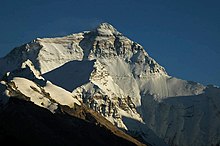
Mount Everest north face from Rongbuk in Tibet
The north ridge route begins from the north side of Everest in Tibet. Expeditions trek to the Rongbuk Glacier, setting up base camp at 5,180 m (16,990 ft) on a gravel plain just below the glacier. To reach Camp II, climbers ascend the medial moraine of the east Rongbuk Glacier up to the base of Changtse at around 6,100 m (20,000 ft). Camp III (ABC—Advanced Base Camp) is situated below the North Col at 6,500 m (21,300 ft). To reach Camp IV on the north col, climbers ascend the glacier to the foot of the col where fixed ropes are used to reach the North Col at 7,010 m (23,000 ft). From the North Col, climbers ascend the rocky north ridge to set up Camp V at around 7,775 m (25,500 ft). The route crosses the North Face in a diagonal climb to the base of the Yellow Band reaching the site of Camp VI at 8,230 m (27,000 ft). From Camp VI, climbers make their final summit push. Climbers face a treacherous traverse from the base of the First Step: ascending from 8,501 to 8,534 m (27,890 to 28,000 ft), to the crux of the climb, the Second Step: ascending from 8,577 to 8,626 m (28,140 to 28,300 ft). (The Second Step includes a climbing aid called the "Chinese ladder", a metal ladder placed semi-permanently in 1975 by a party of Chinese climbers.[83] It has been almost continuously in place since, and ladders have been used by virtually all climbers on the route.) Once above the Second Step the inconsequential Third Step is clambered over: ascending from 8,690 to 8,800 m (28,510 to 28,870 ft). Once above these steps, the summit pyramid is climbed by a snow slope of 50 degrees, to the final summit ridge along which the top is reached.[84]
Death zone
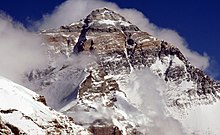
At the higher regions of Mount Everest, climbers seeking the summit typically spend substantial time within the death zone (altitudes higher than 8,000 metres (26,000 ft)), and face significant challenges to survival. Temperatures can dip to very low levels, resulting in frostbite of any body part exposed to the air. Since temperatures are so low, snow is well-frozen in certain areas and death or injury by slipping and falling can occur. High winds at these altitudes on Everest are also a potential threat to climbers.
Another significant threat to climbers is low atmospheric pressure. The atmospheric pressure at the top of Everest is about a third of sea level pressure or 0.333 standard atmospheres (337 mbar), resulting in the availability of only about a third as much oxygen to breathe.[85]
Debilitating effects of the death zone are so great that it takes most climbers up to 12 hours to walk the distance of 1.72 kilometres (1.07 mi) from South Col to the summit.[86] Achieving even this level of performance requires prolonged altitude acclimatization, which takes 40–60 days for a typical expedition. A sea-level dweller exposed to the atmospheric conditions at the altitude above 8,500 m (27,900 ft) without acclimatization would likely lose consciousness within 2 to 3 minutes.[87]
In May 2007, the Caudwell Xtreme Everest undertook a medical study of oxygen levels in human blood at extreme altitude. Over 200 volunteers climbed to Everest Base Camp where various medical tests were performed to examine blood oxygen levels. A small team also performed tests on the way to the summit.[88]
Even at base camp, the low partial pressure of oxygen had direct effect on blood oxygen saturation levels. At sea level, blood oxygen saturation is generally 98–99%. At base camp, blood saturation fell to between 85–87%. Blood samples taken at the summit indicated very low oxygen levels in the blood. A side effect of low blood oxygen is a vastly increased breathing rate, often 80–90 breaths per minute as opposed to a more typical 20–30. Exhaustion can occur merely attempting to breathe.[89]
Lack of oxygen, exhaustion, extreme cold, and climbing hazards all contribute to the death toll. An injured person who cannot walk is in serious trouble, since rescue by helicopter is generally impractical and carrying the person off the mountain is very risky. People who die during the climb are typically left behind. About 150 bodies have never been recovered. It is not uncommon to find corpses near the standard climbing routes.[90]
Supplemental oxygen
Most expeditions use oxygen masks and tanks above 8,000 m (26,000 ft).[91] Everest can be climbed without supplementary oxygen, but only by the most accomplished mountaineers and at increased risk. Humans do not think clearly with low oxygen, and the combination of extreme weather, low temperatures, and steep slopes often require quick, accurate decisions.
The use of bottled oxygen to ascend Mount Everest has been controversial. It was first used on the 1922 British Mount Everest Expedition by George Finch and Geoffrey Bruce who climbed up to 7,800 m (25,600 ft) at a spectacular speed of 1000 vertical feet per hour (vf/h). Pinned down by a fierce storm, they escaped death by breathing oxygen from a jury-rigged set-up during the night. The next day they climbed to 8,100 m (26,600 ft) at 900 vf/h—nearly three times as fast as non-oxygen users. Yet the use of oxygen was considered so unsportsmanlike that none of the rest of the Alpine world recognized this high ascent rate.[citation needed] George Mallory himself described the use of such oxygen as unsportsmanlike, but he later concluded that it would be impossible for him to summit without it and consequently used it on his final attempt in 1924.[92] When Tenzing and Hillary made the first successful summit in 1953, they used bottled oxygen, with the expedition's physiologist Griffith Pugh referring to the oxygen debate as a "futile controversy", noting that oxygen "greatly increases subjective appreciation of the surroundings, which after all is one of the chief reasons for climbing."[93] For the next twenty-five years, bottled oxygen was considered standard for any successful summit.
Reinhold Messner was the first climber to break the bottled oxygen tradition and in 1978, with Peter Habeler, made the first successful climb without it. Although critics alleged that he sucked mini-bottles of oxygen—a claim that Messner denied—Messner silenced them when he summited the mountain solo, without supplemental oxygen or any porters or climbing partners, on the more difficult northwest route, in 1980. Once the climbing community was satisfied that the mountain could be climbed without supplemental oxygen, many purists then took the next logical step of insisting that is how it should be climbed.[94]
The aftermath of the 1996 disaster further intensified the debate. Jon Krakauer's Into Thin Air (1997) expressed the author's personal criticisms of the use of bottled oxygen. Krakauer wrote that the use of bottled oxygen allowed otherwise unqualified climbers to attempt to summit, leading to dangerous situations and more deaths. The disaster was partially caused by the sheer number of climbers (34 on that day) attempting to ascend, causing bottlenecks at the Hillary Step and delaying many climbers, most of whom summitted after the usual 2 pm turnaround time. He proposed banning bottled oxygen except for emergency cases, arguing that this would both decrease the growing pollution on Everest—many bottles have accumulated on its slopes—and keep marginally qualified climbers off the mountain.
The 1996 disaster also introduced the issue of the guide's role in using bottled oxygen.[95] Guide Anatoli Boukreev's decision not to use bottled oxygen was sharply criticized by Jon Krakauer. Boukreev's supporters (who include G. Weston DeWalt, who co-wrote The Climb) state that using bottled oxygen gives a false sense of security.[96]
Krakauer and his supporters point out that, without bottled oxygen, Boukreev could not directly help his clients descend.[97] They state that Boukreev said that he was going down with client Martin Adams,[97] but just below the South Summit, Boukreev determined that Adams was doing fine on the descent and so descended at a faster pace, leaving Adams behind. Adams states in The Climb: "For me, it was business as usual, Anatoli's going by, and I had no problems with that."[98]
Selected climbing records
By the end of the 2010 climbing season, there had been 5,104 ascents to the summit by about 3,142 individuals.[99] Some notable "firsts" by climbers include:- 1922 – First climb to 8,000 metres (26,247 ft), by George Finch and Captain Geoffrey Bruce[100]
- 1952 – First climb to South Col by 1952 Swiss Mount Everest expedition
- 1953 – First ascent by Tenzing Norgay and Edmund Hillary on 1953 British Mount Everest expedition
- 1975 – First female ascent, by Junko Tabei[99]
- 1978 – First ascent without supplemental oxygen by Reinhold Messner and Peter Habeler[101]
- 1980 – First solo ascent, by Reinhold Messner[101]
- 1980 – First winter ascent, by Leszek Cichy and Krzysztof Wielicki[4][5]
- 1988 – First descent by paraglider, by Jean-Marc Boivin[102]
- 1988 – First female ascent without supplemental oxygen by Lydia Bradey[103]
- 1998 – Fastest to reach the summit via the southeast ridge (South Col), without supplemental oxygen, by Kazi Sherpa, in 20 hours and 24 minutes.[104][105][106]
- 2000 – First descent by ski by Davo Karničar[107]
- 2001 – First ascent by a blind climber, Erik Weihenmayer[108]
- 2004 – Fastest to reach the summit via the southeast ridge (South Col), with supplemental oxygen, by Pemba Dorje Sherpa, in 8 hours and 10 minutes.[109]
- 2007 – Fastest to reach the summit via the northeast ridge, without supplemental oxygen, by Christian Stangl, in 58 hours, 45 minutes.[110][111][112]
- 2010 – Youngest to reach the summit, by Jordan Romero (13-year-old)[113]
- 2011/2013 – Most times to reach the summit, jointly held by Apa Sherpa (21 times; 10 May 1990 – 11 May 2011) and Phurba Tashi (21 times; 1999–2013)[58]
- 2012 – Oldest female to reach the summit, by Tamae Watanabe (73-year-old)[114]
- 2013 – Oldest to reach the summit, by Yuichiro Miura, 80 years old[115]
1996 disaster
On 11 May 1996 eight climbers died after several expeditions were caught in a blizzard high up on the mountain. During the entire 1996 season, 15 people died while climbing on Mount Everest. These were the highest death tolls for a single event, and for a single season, until the sixteen deaths in the 2014 Mount Everest avalanche. The disaster gained wide publicity and raised questions about the commercialization of climbing Mount Everest.Journalist Jon Krakauer, on assignment from Outside magazine, was in one of the affected parties, and afterwards published the bestseller Into Thin Air, which related his experience. Anatoli Boukreev, a guide who felt impugned by Krakauer's book, co-authored a rebuttal book called The Climb. The dispute sparked a debate within the climbing community. In May 2004, Kent Moore, a physicist, and John L. Semple, a surgeon, both researchers from the University of Toronto, told New Scientist magazine that an analysis of weather conditions on 11 May suggested that freak weather caused oxygen levels to plunge approximately 14%.[116][117]
The storm's impact on climbers on the North Ridge of Mount Everest, where several climbers also died, was detailed in a first-hand account by British filmmaker and writer Matt Dickinson in his book The Other Side of Everest. 16-year-old Mark Pfetzer was on the climb and wrote about it in his account, Within Reach: My Everest Story.
A feature film titled Everest based on the actual events of this disaster is currently in production with director Baltasar Kormákur for 2015 release.[118]
2005 helicopter landing
In May 2005, pilot Didier Delsalle of France landed a Eurocopter AS350 B3 helicopter on the summit of Mount Everest.[119] He needed to land for two minutes to set the Fédération Aéronautique Internationale (FAI) official record, but he stayed for about four minutes, twice.[119] In this type of landing the rotors stay engaged, which avoids relying on the snow to fully support the aircraft. The flight set rotorcraft world records, for highest of both landing and take-off.[120]Some press reports suggested that the report of the summit landing was a misunderstanding of a South Col landing, but he had also landed on South Col two days earlier,[121] with this landing and the Everest records confirmed by the FAI.[120] Delsalle also rescued two Japanese climbers at 16,000 ft (4,880 m) while he was there. One climber noted that the new record meant a better chance of rescue.[119]
2006 controversy
Double-amputee climber Mark Inglis revealed in an interview with the press on 23 May 2006, that his climbing party, and many others, had passed a distressed climber, David Sharp, on 15 May, sheltering under a rock overhang 450 metres (1,480 ft) below the summit, without attempting a rescue.[122] The revelation sparked wide debate on climbing ethics, especially as applied to the arduous conditions in the death zone of the highest 850 m of Everest.The climbers who left him said that the rescue efforts would have been useless and only have caused more deaths. Much of this controversy was captured by the Discovery Channel while filming the television program Everest: Beyond the Limit. A crucial decision affecting the fate of Sharp is shown in the program, where an early returning climber Lebanese adventurer Maxim Chaya is descending from the summit and radios to his base camp manager (Russell Brice) that he has found a frostbitten and unconscious climber in distress. Maxim Chaya is unable to identify Sharp, who had chosen to climb solo without any support and so did not identify himself to other climbers. The base camp manager assumes that Sharp is part of a group that has already calculated that they must abandon him, and informs his lone climber that there is no chance of him being able to help Sharp by himself. As Sharp's condition deteriorates through the day and other descending climbers pass him, his opportunities for rescue diminish: his legs and feet curl from frostbite, preventing him from walking; the later descending climbers are lower on oxygen and lack the strength to offer aid; time runs out for any Sherpas to return and rescue him. Most importantly, Sharp's decision to climb without support left him with no margin for recovery.
As this debate raged, on 26 May, Australian climber Lincoln Hall was found alive, after being declared dead the day before. He was found by a party of four climbers (Dan Mazur, Andrew Brash, Myles Osborne and Jangbu Sherpa) who, giving up their own summit attempt, stayed with Hall and descended with him and a party of 11 Sherpas sent up to carry him down. Hall later fully recovered. Similar actions have been recorded since, including on 21 May 2007, when Canadian climber Meagan McGrath initiated the successful high-altitude rescue of Nepali Usha Bista. Recognizing her heroic rescue, Major Meagan McGrath was selected as a 2011 recipient of the Sir Edmund Hillary Foundation of Canada Humanitarian Award, which recognizes a Canadian who has personally or administratively contributed a significant service or act in the Himalayan Region of Nepal.[123]
Ascent statistics to 2010
By the end of the 2010 climbing season, there had been 5,104 ascents to the summit by about 3,142 individuals, with 77% of these ascents being accomplished since 2000.[99] The summit was achieved in 7 of the 22 years from 1953 to 1974, and has not been missed since 1975.[99] In 2007, the record number of 633 ascents was recorded, by 350 climbers and 253 sherpas.[99]
A remarkable illustration of the explosion of popularity of Everest is provided by the numbers of daily ascents. Analysis of the 1996 Mount Everest disaster shows that part of the blame was on the bottleneck caused by the large number of climbers (33 to 36) attempting to summit on the same day; this was considered unusually high at the time. By comparison, on 23 May 2010, the summit of Mount Everest was reached by 169 climbers – more summits in a single day than in the cumulative 31 years from the first successful summit in 1953 through 1983.[99]
There have been 219 fatalities recorded on Mount Everest from the 1922 British Mount Everest Expedition through the end of 2010, a rate of 4.3 fatalities for every 100 summits (this is a general rate, and includes fatalities amongst support climbers, those who turned back before the peak, those who died en route to the peak and those who died while descending from the peak). Of the 219 fatalities, 58 (26.5%) were climbers who had summited but did not complete their descent.[99] Though the rate of fatalities has decreased since the year 2000 (1.4 fatalities for every 100 summits, with 3938 summits since 2000), the significant increase in the total number of climbers still means 54 fatalities since 2000: 33 on the northeast ridge, 17 on the southeast ridge, 2 on southwest face, and 2 on north face.[99]
Nearly all attempts at the summit are done using one of the two main routes. The traffic seen by each route varies from year to year. In 2005–07, more than half of all climbers elected to use the more challenging, but cheaper northeast route. In 2008, the northeast route was closed by the Chinese government for the entire climbing season, and the only people able to reach the summit from the north that year were athletes responsible for carrying the Olympic torch for the 2008 Summer Olympics.[124] The route was closed to foreigners once again in 2009 in the run-up to the 50th anniversary of the Dalai Lama's exile.[125] These closures led to declining interest in the north route, and, in 2010, two-thirds of the climbers reached the summit from the south.[99]
2014 avalanche
On 18 April 2014, an avalanche hit the area just below the Base Camp 2 at around 0100 UTC (0630 local time) and at an elevation of about 5,900 metres.[126] Sixteen climbers were killed in the avalanche and nine more were injured.[127]A week later, the Nepalese route to Everest was closed to climbers temporarily due to bad weather. According to Nepal's tourism ministry the last time the route was closed was in 1987 due to bad weather.[128]
Everest economy
Climbing Mount Everest can be a relatively expensive undertaking for climbers. Climbing gear required to reach the summit may cost in excess of US$8,000, and most climbers also use bottled oxygen, which adds around US$3,000. The permit to enter the Everest area from the south via Nepal costs US$10,000 to US$25,000 per person, depending on the size of the team. The ascent typically starts in one of the two base camps near the mountain, both of which are approximately 100 kilometres (60 mi) from Kathmandu and 300 kilometres (190 mi) from Lhasa (the two nearest cities with major airports); transferring one's equipment from the airport to the base camp may add as much as US$2,000.[citation needed]
Beyond this point, costs may vary widely. It is technically possible to reach the summit with minimal additional expenses, and there are "budget" travel agencies which offer logistical support for such trips. However, this is considered difficult and dangerous (as illustrated by the case of David Sharp). Many climbers hire "full service" guide companies, which provide a wide spectrum of services, including acquisition of permits, transportation to/from base camp, food, tents, fixed ropes,[130] medical assistance while on the mountain, an experienced mountaineer guide, and even personal porters to carry one's backpack and cook one's meals. The cost of such a guide service may range from $40,000 to $80,000 per person.[131] Since most equipment is moved by Sherpas, clients of full-service guide companies can often keep their backpack weights under 10 kilograms (22 lb), or hire a Sherpa to carry their backpack for them. By contrast, climbers attempting less commercialized peaks, like Mount McKinley, are often expected to carry backpacks over 30 kilograms (66 lb) and, occasionally, to tow a sled with 35 kilograms (77 lb) of gear and food.[132]
According to Jon Krakauer, the era of commercialization of Everest started in 1985, when the summit was reached by a guided expedition led by David Breashears that included Richard Bass, a wealthy 55-year old businessman and an amateur mountain climber with only four years of climbing experience.[133] By the early 1990s, multiple companies were offering guided tours to the mountain. Rob Hall, one of the mountaineers who died in the 1996 disaster, had successfully guided 39 clients to the summit prior to that incident.[134]
The degree of commercialization of Mount Everest is a frequent subject of criticism. Jamling Tenzing Norgay, the son of Tenzing Norgay, said in a 2003 interview that his late father would have been shocked to discover that rich thrill-seekers with no climbing experience were now routinely reaching the summit:
You still have to climb this mountain yourself with your feet. But the spirit of adventure is not there any more. It is lost. There are people going up there who have no idea how to put on crampons. They are climbing because they have paid someone $65,000. It is very selfish. It endangers the lives of others.[135]Reinhold Messner concurred in 2004:
You could die in each climb and that meant you were responsible for yourself. We were real mountaineers: careful, aware and even afraid. By climbing mountains we were not learning how big we were. We were finding out how breakable, how weak and how full of fear we are. You can only get this if you expose yourself to high danger. I have always said that a mountain without danger is not a mountain. ... High-altitude alpinism has become tourism and show. These commercial trips to Everest, they are still dangerous. But the guides and organisers tell clients, "Don't worry, it's all organised." The route is prepared by hundreds of Sherpas. Extra oxygen is available in all camps, right up to the summit. People will cook for you and lay out your beds. Clients feel safe and don't care about the risks.[136]However, not all opinions on the subject among prominent mountaineers are strictly negative. For example, Edmund Hillary, who went on record saying that he has not liked "the commercialization of mountaineering, particularly of Mt. Everest"[137] and claimed that "Having people pay $65,000 and then be led up the mountain by a couple of experienced guides ... isn't really mountaineering at all",[138] nevertheless noted that he was pleased by the changes brought to Everest area by the Westerners:
I don't have any regrets because I worked very hard indeed to improve the condition for the local people. When we first went in there they didn't have any schools, they didn't have any medical facilities, all over the years we have established 27 schools, we have two hospitals and a dozen medical clinics and then we've built bridges over wild mountain rivers and put in fresh water pipelines so in cooperation with the Sherpas we've done a lot to benefit them.[139]On Friday, April 18, 2014, 16 Sherpas died in Nepal, after an avalanche swept them off Mount Everest. In response to that tragedy and others caused by Sherpas' deaths and injuries sustained while servicing untrained climbers and climbers burdening Sherpas with unreasonable requests, and the lack of government support for Sherpas injured or killed in that service, numerous Sherpa climbing guides have walked off the job, and some climbing companies are closing their services on that mountain.[140][141]
Climbing crimes
Some climbers have reported life-threatening thefts from supply caches. Vitor Negrete, the first Brazilian to climb Everest without oxygen and part of David Sharp's party, died during his descent, and theft from his high-altitude camp may have contributed.[142][143]In addition to theft, Michael Kodas describes in his book High Crimes: The Fate of Everest in an Age of Greed (2008),[144] unethical guides and Sherpas, prostitution and gambling at the Tibet Base Camp, fraud related to the sale of oxygen bottles, and climbers collecting donations under the pretense of removing trash from the mountain.[145][146]
Everest and religion
The southern part of Mt. Everest is regarded as one of several "hidden valleys" of refuge designated by Padmasambhava, a ninth-century "lotus-born" Buddhist saint.[147]
Near the base of the north side of Mt. Everest lies Rongbuk Monastery, which is the "sacred threshold to Mount Everest", with the most dramatic views of the world.[148] For Sherpas living on the slopes of Everest in the Khumbu region of Nepal, Rongbuk Monastery was an important pilgrimage site, accessed in a few days of travel across the Himalaya through Nangpa La.[149]
Miyolangsangma, a Tibetan Buddhist "Goddess of Inexhaustible Giving", is believed to have lived at the top of Mt. Everest. According to Sherpa Buddhist monks, Mt. Everest is Miyolangsangma's palace and playground, and all climbers are only partially welcome guests, having arrived without invitation.[147]
The Sherpa people also believe that Mt. Everest and its flanks are blessed with spiritual energy, and one should show reverence when passing through this sacred landscape. Here, the karmic effects of one's actions are magnified, and impure thoughts are best avoided.[147]
Map

Southern and northern climbing routes as seen from the International Space Station. (The names on the photo are links to corresponding pages.)
Northern panoramic view of Everest from below the Gyatso La on the Friendship Highway between Lhatse and Shelkar
